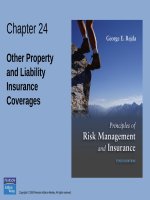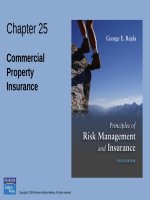Principles of risk management and insurance 12th by rejde mcnamara chapter 23
Bạn đang xem bản rút gọn của tài liệu. Xem và tải ngay bản đầy đủ của tài liệu tại đây (861.98 KB, 29 trang )
Chapter 23
Auto Insurance
and Society
Agenda
• Approaches for Compensating Auto
Accident Victims
• Auto Insurance for High-Risk Drivers
• Cost of Auto Insurance
• Shopping for Auto Insurance
Copyright ©2014 Pearson Education, Inc. All rights reserved.
23-2
Approaches for Compensating Auto
Accident Victims
• Many accident victims are unable to recover
damages
– The negligent driver may be uninsured or
underinsured
• States use a number of approaches to
protect accident victims from irresponsible
or reckless drivers
• A financial responsibility law requires
motorists to furnish proof of financial
responsibility up to certain minimum dollar
limits
Copyright ©2014 Pearson Education, Inc. All rights reserved.
23-3
Approaches for Compensating Auto
Accident Victims
• Evidence of financial responsibility can be
provided in several ways:
– Producing evidence of an auto liability insurance
policy with at least certain minimum limits
– Posting a bond
– Depositing the amount required by law
– Showing that the person is a qualified self-insurer
• Financial responsibility laws provide limited
protection against irresponsible motorists
– There is no guarantee that all accident victims
will be paid
– State laws require only minimum liability limits,
which are relatively low
Copyright ©2014 Pearson Education, Inc. All rights reserved.
23-4
Exhibit 23.1 Automobile Financial Responsibility
Limits by State
Copyright ©2014 Pearson Education, Inc. All rights reserved.
23-5
Exhibit 23.1
Automobile
Financial
Responsibility
Limits by State
Copyright ©2014 Pearson Education, Inc. All rights reserved.
23-6
Approaches for Compensating Auto
Accident Victims
• A compulsory insurance law requires
motorists to carry at least a minimum
amount of liability insurance before the
vehicle can be licensed or registered
– Some argue that the law provides greater
protection against uninsured drivers because
motorists must provide evidence of financial
responsibility before an accident occurs
– Critics cite: mandatory insurance does not
reduce the number of uninsured drivers
– Computer reporting systems to track uninsured
motorists have not been effective
Copyright ©2014 Pearson Education, Inc. All rights reserved.
23-7
Approaches for Compensating Auto
Accident Victims
• Three states (MI, NY, ND) have established
unsatisfied judgment funds for
compensating auto accident victims who
have exhausted all other means of recovery
– The accident must obtain a judgment against
the negligent motorist and show that the
judgment cannot be collected
– The amount paid by the fund is limited by state
law and may be reduced by collateral sources
– The negligent driver must repay the fund
– States use different methods for financing the
benefits, e.g., through insurer assessments
Copyright ©2014 Pearson Education, Inc. All rights reserved.
23-8
Approaches for Compensating Auto
Accident Victims
• Many states require uninsured motorists
coverage
– The injured person’s insurer agrees to
compensate for bodily injury caused by an
uninsured motorist, a hit-and-run driver, or a
negligent driver whose insurer is insolvent
– One advantage is that claim settlement is faster
than a tort liability lawsuit
– The injured person must show that the uninsured
motorist is legally liable for the accident
– The minimum limits are low, so an accident
victim may not be fully compensated
Copyright ©2014 Pearson Education, Inc. All rights reserved.
23-9
Approaches for Compensating Auto
Accident Victims
• Low-cost auto insurance provides minimum
amounts of liability insurance at reduced
rates to motorists who cannot afford regular
insurance
– Goal is to reduce the number of uninsured
drivers
• Several states have enacted “no pay, no
play” laws which prohibit uninsured
motorists from suing negligent drivers for
noneconomic damages
Copyright ©2014 Pearson Education, Inc. All rights reserved.
23-10
No-fault Auto Insurance
• No-fault auto insurance is another method
for compensating injured accident victims
• About half of the states have some type of
no-fault law in effect
– After an auto accident involving bodily injury,
each party collects from his or her own insurer
regardless of fault
– Enacted because of dissatisfaction and defects
in the traditional tort liability system
Copyright ©2014 Pearson Education, Inc. All rights reserved.
23-11
No-fault Auto Insurance
• No-fault plans vary among the states
• Under a pure no-fault plan, accident victims
cannot sue at all, regardless of the amount of
the claim
• Under a modified no-fault plan, victims have
a limited right to sue
– In some states, an injured driver may sue if the
bodily injury claim exceeds a certain monetary
threshold
– In some states, an injured driver may sue if the
bodily injury claim exceeds a verbal threshold,
e.g., if the injury involves death, dismemberment,
disfigurement, or permanent loss of a bodily
member or function
Copyright ©2014 Pearson Education, Inc. All rights reserved.
23-12
No-fault Auto Insurance
• An add-on plan pays benefits to an accident
victim without regard to fault, and the
injured person has the right to sue the
negligent driver who caused the accident
– Not a true no-fault plan
• Under a choice no-fault plan, motorists can
elect to be covered under the state’s nofault law and pay lower premiums
– Or, they can retain the right to sue under the
tort liability system and pay higher premiums
Copyright ©2014 Pearson Education, Inc. All rights reserved.
23-13
No-fault Auto Insurance
• No-fault benefits are provided by adding an
endorsement to an auto insurance policy
• Benefits are restricted to the injured
person’s economic loss, which includes:
–
–
–
–
–
Medical expenses
Loss of earnings
Essential services expenses, e.g., housework
Funeral expenses
Survivors’ loss benefits,
Copyright ©2014 Pearson Education, Inc. All rights reserved.
23-14
No-fault Auto Insurance
• In some states, insurers must also offer
optional no-fault benefits above the
prescribed minimums
• The right to sue varies across states with nofault or add-on plans
– All states permit a lawsuit in the event of a serious
injury
• No-fault laws cover only bodily injury and not
property damage
– Except in Michigan
– Motorists are allowed to sue the negligent driver for
property damage
Copyright ©2014 Pearson Education, Inc. All rights reserved.
23-15
No-fault Auto Insurance
• Arguments in support of no-fault laws
include:
– Difficulty in determining fault
– Inequity in claim payments
– High transactions costs and attorney fees
– Fraudulent and inflated claims
– Delay in payments
Copyright ©2014 Pearson Education, Inc. All rights reserved.
23-16
No-fault Auto Insurance
• Arguments against no-fault laws include:
– Defects of the negligence system are
exaggerated
– Savings from no-fault are exaggerated
– Court delays are confined to a few large cities
– Safe drivers may be penalized by no-fault
– No-fault provides no payment for pain and
suffering
– The present tort liability system should be
improved, not junked
Copyright ©2014 Pearson Education, Inc. All rights reserved.
23-17
No-fault Auto Insurance
• Some states have repealed their no-fault
laws because relatively low monetary
thresholds have increased the number of
lawsuits
• A study by the Institute for Civil Justice
found that no-fault plans:
– reduce attorney fees and claim processing costs
– match the compensation received for an injury
more closely with the economic loss sustained
– generally pay benefits more quickly
Copyright ©2014 Pearson Education, Inc. All rights reserved.
23-18
Auto Insurance for High Risk Drivers
• High risk drivers who have difficulty
obtaining auto insurance in the voluntary
market can obtain insurance in the shared
(residual) market
• Most states have an auto insurance plan
(assigned risk plan) that makes auto
insurance available to motorists who are
unable to obtain insurance in the voluntary
market
– All auto insurers in the state are assigned a
proportionate share of high-risk drivers
– Premiums charged are substantially higher than
those charged in the voluntary markets
Copyright ©2014 Pearson Education, Inc. All rights reserved.
23-19
Exhibit 23.2 Example of an Automobile
Insurance Plan (Generalized)
Copyright ©2014 Pearson Education, Inc. All rights reserved.
23-20
Auto Insurance for High Risk Drivers
• A few states have established a joint
underwriting association (JUA), in which auto
insurers in the state participate in providing
coverage to high-risk drivers through a
common pool
– Each insurer pays its pro rata share of pool losses
and expenses
– The JUA designs the policies and sets the rates
– Underwriting losses are proportionately shared by
the companies based on premiums written
– A limited number of insurers are designated as
servicing insurers, but all insurers participate in the
pool
Copyright ©2014 Pearson Education, Inc. All rights reserved.
23-21
Auto Insurance for High Risk Drivers
• A few states have established a reinsurance
facility (or pool) for placing high-risk drivers
• The Maryland Automobile Insurance Fund
provides insurance to high-risk drivers who
have been canceled or refused insurance by
private insurers
• Specialty insurers are insurers that
specialize in insuring motorists with poor
driving records
Copyright ©2014 Pearson Education, Inc. All rights reserved.
23-22
Cost of Auto Insurance
• Auto insurance rates have increased in recent
years due to:
– Rising medical and motor vehicle repair costs
– Soaring jury awards in liability cases
– Insurance fraud and abuse
• Insurers use a variety of factors to establish
auto insurance premiums, including:
–
–
–
–
–
–
Age, gender, and marital status
Territory
Use of the auto
Driver education and individual driving record
Number and types of cars
insurance score
Copyright ©2014 Pearson Education, Inc. All rights reserved.
23-23
Exhibit 23.3 Top Five Most Expensive and Least
Expensive Cities for Automobile Insurance, 2011*
Copyright ©2014 Pearson Education, Inc. All rights reserved.
23-24
Exhibit 23.4 Drivers in Motor Vehicle Crashes
by Age, 2009
Copyright ©2014 Pearson Education, Inc. All rights reserved.
23-25









